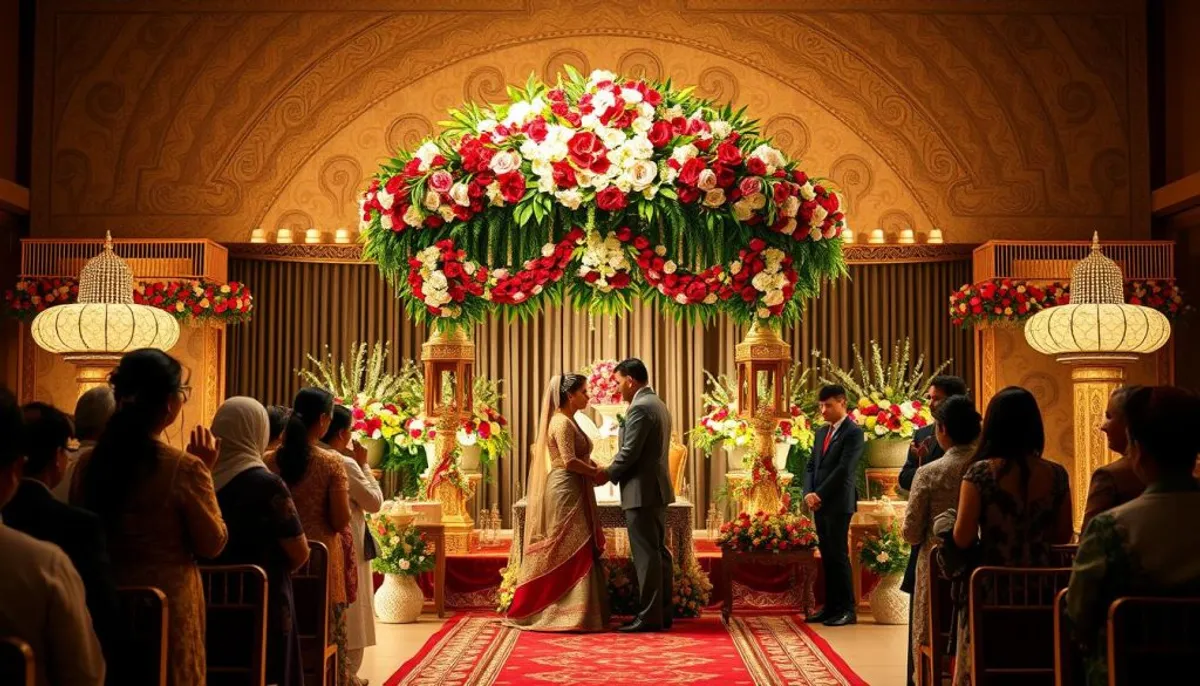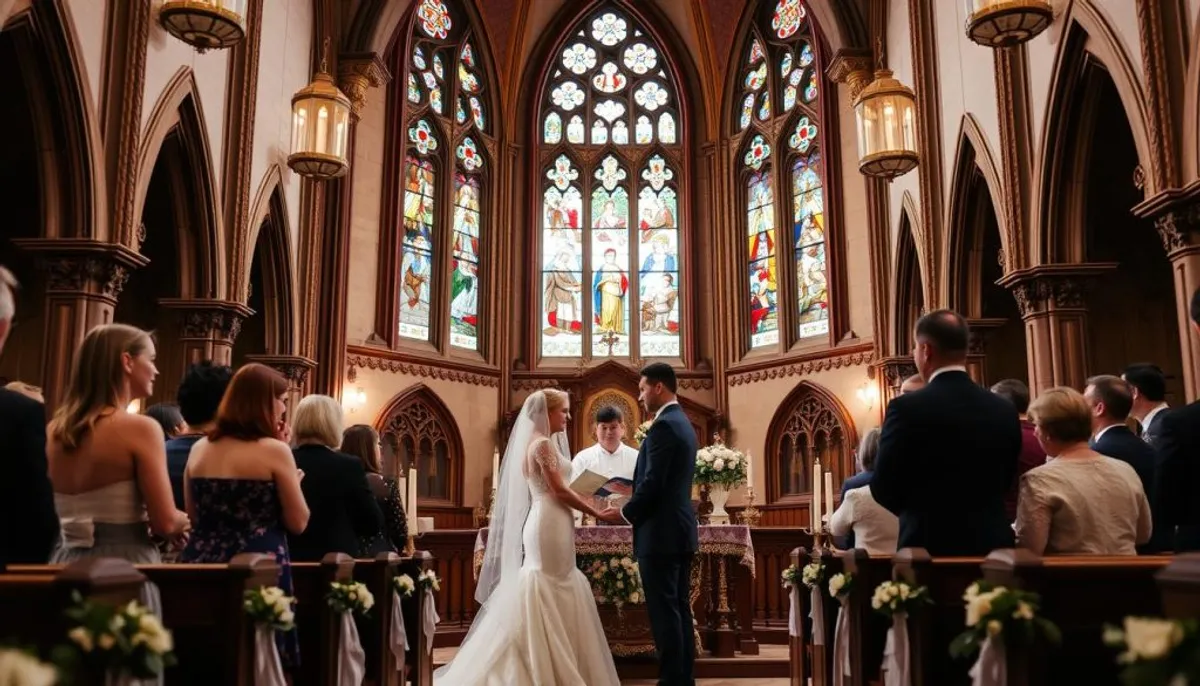The wedding ceremony in France is a fascinating journey through rich and varied nuptial rites. These French customs, rooted in history, celebrate the sacred union of two people with a unique and personal touch.
From engagements to preparations, each step is imbued with symbolism. The white dress, exchanged rings, and the tossed bouquet are traditions that mark this special day. These rites, craftsmanship and artisanal, passed down from generation to generation, evolve while retaining their essence.

The French customs are also enriched by diverse cultural influences. From the throwing of rice symbolizing fertility to the Japanese sake ceremony, each country brings its unique touch. In Italy, the “confetti” offered in five pieces represents health, wealth, fertility, longevity, and happiness.
These traditions, whether ancient or modern, create magical and unforgettable moments. They weave a connection between the past and the present, celebrating love and commitment in all its splendor.
The history and evolution of wedding traditions in France
The history of marriage in France is a fascinating adventure, marked by the constant evolution of customs and traditions. From ancient times to the present day, wedding ceremonies have followed the social and cultural transformations of the country. They reflect the very essence of France, perpetuating rituals rooted in the past while integrating modern elements.
From ancient origins to modern practices
In the Roman Empire, the bride stood out in her most sumptuous dress, often red. In the Middle Ages, engagements had to be realized within the year following their announcement. Queen Victoria marked a turning point by popularizing the white dress, a symbol of purity and virginity.
The influence of different cultures on French traditions
Cultural influences have profoundly marked French customs. For instance, the tradition of throwing rice or petals on the newlyweds after the civil ceremony reflects various influences. The celebration venues, such as castles and vineyards, reflect French history and romance.
The evolution of customs over time
The evolution of wedding traditions in France is marked by significant changes. Wedding rings have evolved from a simple iron band in the Middle Ages to elaborate designs. Wedding menus now incorporate gourmet dishes and fine wines, highlighting the importance of cuisine in French culture.
| Era | Tradition | Evolution |
|---|---|---|
| Antiquity | Dress of varied color | White dress (19th century) |
| Middle Ages | Iron ring | Varied and precious designs |
| Today | Civil ceremony mandatory | Elaborate gourmet receptions |
French wedding customs continue to evolve, blending ancestral traditions with modern innovations, thus reflecting the cultural richness of the country.
The preparatory rituals before the big day
Wedding preparations extend far beyond the big day. Engagements mark the beginning of this adventure. They are the moment when the couple announces their commitment to their loved ones. This step is often celebrated with an intimate party.
After the engagement, sending out invitations becomes essential. These official invitations announce the date and location of the wedding. They often reflect the style and personality of the future spouses. Choosing the design and text requires time and thought.
The bachelor party is a popular tradition. Friends of the future spouses organize this surprise party. It marks the end of single life and the beginning of a new chapter. These evenings are often filled with laughter and unforgettable memories.
These rituals create excitement around the wedding. They allow the future spouses to share their happiness with their loved ones. Each step brings them closer to the big day. The wedding preparations are as important as the ceremony itself. They forge bonds and create precious memories for the couple and their guests.
What tradition for a wedding: the essential elements
Wedding traditions in France are deeply rooted in symbols and profound meanings. Each component plays a crucial role in the celebration of the union of the spouses.
The white dress and its symbols
The wedding dress in white is an emblematic symbol. It embodies purity and innocence. This tradition dates back to the 19th century and remains popular. Today's brides add unique touches to their dresses, personalizing them.
The veil and the garter
The veil, once a symbol of virginity, is now an elegant accessory. The garter, on the other hand, is a playful tradition. These elements add a touch of romance to the bride's outfit.
The rings and their meaning
The wedding rings, worn on the left ring finger, symbolize the mutual commitment of the spouses. This strong moment of the ceremony reflects the union of the two. The choice of rings often reflects the couple's personal tastes.
The four lucky elements
The tradition of the four lucky elements is very widespread. It includes: expectoration culture, communicate with france culture
- Something old: symbolizes continuity
- Something new: represents optimism for the future
- Something borrowed: brings luck from a married friend
- Something blue: signifies fidelity and pure love
These wedding good luck charms bring a personal and sentimental dimension to the celebration. They allow the bride to incorporate meaningful elements into her outfit while respecting traditions.
The ceremonies and their symbols
In France, the civil ceremony is essential to legalize the union. It takes place at the town hall, where the future spouses express their consent before the mayor. This step emphasizes the obligations and rights of the spouses, by reading articles from the Civil Code.
After the civil ceremony, many couples opt for a religious ceremony. This ceremony, enriched with rituals, brings a spiritual dimension to the union. The exchange of vows and the blessing of the rings are moments filled with symbolism.

The exit from the church is marked by festive traditions. The throwing of rice, a symbol of prosperity, is often replaced by eco-friendly alternatives like flower petals. These traditions adapt to current concerns while preserving their nuptial symbolism.
| Type of ceremony | Characteristics | Symbolism |
|---|---|---|
| Civil ceremony | Mandatory, at the town hall | Legal commitment |
| Religious ceremony | Optional, at the church | Spiritual blessing |
| Exit traditions | Throwing rice or petals | Prosperity and fertility |
Wedding ceremonies in France combine tradition and modernity. They allow couples to personalize their union while respecting legal and cultural aspects, as well as French traditions. Each step, from the civil ceremony to religious rituals, creates a unique and unforgettable moment.
The festive traditions during the reception
The wedding reception is the pinnacle of the festivities, enriched by a multitude of traditions. These customs give a unique magic to the event, leaving indelible memories for all. They transform the union into an unforgettable moment for the newlyweds and their guests.
The honor wine and its customs
The honor wine is the first step towards celebration. This French tradition allows guests to greet the newlyweds, strengthening bonds in a friendly atmosphere. It is also the perfect time to sign the guestbook, leaving messages of love and wishes for the newlyweds.
The traditional wedding meal
The wedding meal reflects the culture and tastes of the newlyweds. The pièce montée, a culinary masterpiece, occupies the center of the tables. Its layers symbolize the union of the spouses. The sugared almonds, offered as souvenirs, add a touch of elegance to this tradition.
The traditional dances and entertainment
The entertainment begins with the first dance of the newlyweds, a magical moment symbolizing their union. The bouquet toss creates palpable excitement. The emotional speeches and toasts from loved ones add a sincere note to the celebration.
| Tradition | Symbolism | Moment of the reception |
|---|---|---|
| Honor wine | Welcome and congratulations | Beginning of the reception |
| Pièce montée | Union of the spouses | During the meal |
| First dance | Love and union | Opening of the ball |
| Bouquet toss | Passing on happiness | End of the evening |
The end-of-celebration rituals
The end of the wedding evening is marked by traditions that add a magical touch to the event. These symbolic rituals allow the newlyweds and their guests to conclude the day memorably.
The bouquet toss remains a staple. The bride throws her bouquet to a group of single women. The one who catches it is said to be the next to marry. This moment often creates a joyful and exciting atmosphere.

The garter ritual is equally popular. The groom removes the garter from the bride, sometimes with his teeth for added fun, and then tosses it to the single men. This tradition adds a note of sensuality to the evening.
Other modern rituals are gaining popularity. The release of sky lanterns allows guests to write their wishes for the newlyweds before sending them off. It’s a magical moment that lights up the night sky.
| Ritual | Symbolism | Popularity |
|---|---|---|
| Bouquet toss | Future bride | Very high |
| Garter | Sensuality | High |
| Lantern release | Wishes and hopes | Growing |
These traditions mark the official end of the celebrations while allowing the party to continue. They create precious memories for the newlyweds and their guests, beautifully concluding this special day.
Conclusion
Wedding traditions in France remain essential in celebrating love. They manifest through a multitude of customs, from engagements to the bouquet toss. These rituals shape an unforgettable atmosphere for the newlyweds and their guests.
The modern wedding adapts, integrating new practices while preserving the essence of traditions. For example, the bachelor party, originally reserved for men, is now honored by women. This evolution illustrates the adaptability of customs to current values.
The personalization of customs has become a significant trend. Couples incorporate traditional elements, such as the white dress or rings, with personal touches. These choices reflect their story and personality, creating a unique wedding that respects cultural heritage.
Whether it’s throwing rice to wish for prosperity or carrying the bride, each tradition holds significance. The choice of traditions should match the couple's identity. Thus, the wedding becomes a harmonious blend of tradition and modernity.
RelatedRelated articles


